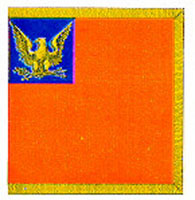Civil War Facts |
Colonial Wars |
American Wars |
Link To This Page — Contact Us —
IV Corps Civil War Facts
Army of the Cumberland

This corps was composed of fighting regiments. Of the regiments in the Western armies, take the ones that sustained the greatest losses in battle, and it will be found that more of them were in the Fourth Corps than in any other. Although all of their fighting was not done while in the Fourth Corps, it was done either in it or in the 2 corps which were consolidated in order to form the IV Corps.
On October 9, 1863, the IV Corps was organized by the consolidation of the 27th (McCook's) and 21st (Crittenden's) Corps, in compliance with the President's order of September 28th. Though newly-formed, it was composed of veteran brigades whose battle flags were scarred with the marks of hard fought fields; within this new command they were destined to wave amid the smoke and fire of many more. The command of the IV Corps was given to Gen. Gordon Granger, the man who marched his division to Chickamauga with no other orders or direction than "the sound of the enemy's cannon." The 3 divisions of this new corps were placed under the commands of Gens. Palmer, Sheridan, and Wood. Soon after its organization the corps went into action at Missionary Ridge, where it distinguished itself by its brilliant and successful charge up the heights. In this battle, the 2 divisions of Sheridan and Wood lost 280 killed, 2,078 wounded, and 12 missing; total, 2,370, or more than half the casualties at Missionary Ridge. The first division, under command of Gen. Cruft, was also engaged.
During the following winter, the corps marched to the relief of Knoxville, a campaign memorable for the suffering, hunger, and hardships endured by the men. In May, 1864, it moved on the Atlanta campaign, Gen. Howard commanding the corps, and Generals Stanley, Newton, and Wood the divisions. Its hardest fighting during that campaign occurred at Pickett's Mills, and in the unsuccessful assault on Kenesaw Mountain.
After the evacuation of Atlanta, the IV and XXIII Corps, under Gen. Thomas, marched northward to confront Gen. John B. Hood's Confederate forces, while Maj. Gen. William T. Sherman, with the main army, wended his way, unmolested, to the sea. Gen. Stanley was then in command of the IV Corps, Gen. Howard, having been promoted to the command of the Army of the Tennessee, upon the death of Mac Pherson; Kimball, Wagner, and Wood were in command of the divisions. On November 20, 1864, a few days before the battle of Spring Hill, the corps numbered 14,715 present for duty; about 2,200 more joined before the battle of Franklin. In that battle the Confederates received the bloodiest repulse of the war, their men fighting with unusual desperation, while 12 of their generals were killed or wounded in their unsuccessful attack on the Union intrenchments.
At Franklin, Opdycke's Brigade of the IV Corps won special distinction by its promptness and gallantry in retaking a part of the works which the enemy had seized. Stanley was severely wounded in this action, and Gen. Thomas J. Wood succeeded to his place.
Wood had served with honor in the armies of the Ohio, and the Cumberland, from the commencement of the war. He commanded the IV Corps in its last battle --its last victory, at Nashville. His division generals in that engagement were Kimball, Elliott, and Beatty; the casualties in the corps were 135 killed, 834 wounded and 22 missing; total, 991. The corps joined in the pursuit of Hood's defeated army, after which Wood assembled it at Huntsville, Ala., arriving there January 5, 1865.
On March 15th, it moved into East Tennessee, in order to prevent the possible escape of Lee's and Johnston's armies, returning in April to Nashville, where it remained until June 16th, when it was ordered to New Orleans, en route for Texas. Although the war had virtually ended, the IV Corps remained in Texas during the rest of 1865, forming a part of Sheridan's Army of Occupation. The most of the regiments were, however, mustered out in December, 1865, in time for the men to spend Christmas in their homes.
Major Battles Fought In
|
|
